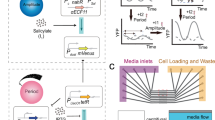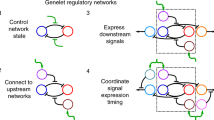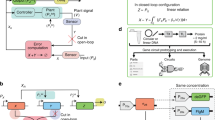Abstract
Networks of interacting biomolecules carry out many essential functions in living cells1, but the ‘design principles’ underlying the functioning of such intracellular networks remain poorly understood, despite intensive efforts including quantitative analysis of relatively simple systems2. Here we present a complementary approach to this problem: the design and construction of a synthetic network to implement a particular function. We used three transcriptional repressor systems that are not part of any natural biological clock3,4,5 to build an oscillating network, termed the repressilator, in Escherichia coli. The network periodically induces the synthesis of green fluorescent protein as a readout of its state in individual cells. The resulting oscillations, with typical periods of hours, are slower than the cell-division cycle, so the state of the oscillator has to be transmitted from generation to generation. This artificial clock displays noisy behaviour, possibly because of stochastic fluctuations of its components. Such ‘rational network design’ may lead both to the engineering of new cellular behaviours and to an improved understanding of naturally occurring networks.
This is a preview of subscription content, access via your institution
Access options
Subscribe to this journal
Receive 51 print issues and online access
$199.00 per year
only $3.90 per issue
Buy this article
- Purchase on Springer Link
- Instant access to full article PDF
Prices may be subject to local taxes which are calculated during checkout



Similar content being viewed by others
References
Bray, D. Protein moelcules as computational elements in living cells. Nature 376, 307–312 (1995).
Koshland, D. E. Jr The era of pathway quantification. Science 280, 852–853 ( 1998).
Winfree, A. T. The Geometry of Biological Time (Springer, Berlin, 1990).
Goldbeter, A. Biochemical Oscillations and Cellular Rhythms (Cambridge Univ. Press, 1996).
Thomas, R. & D'Ari, R. Biological Feedback (CRC Press, Boca Raton, 1990).
Lutz, R. & Bujard, H. Independent and tight regulation of transcriptional units in Escherichia coli via the LacR/O, the TetR/O and AraC/I1-I2 regulatory elements. Nucleic Acids Res. 25, 1203–1210 (1997).
Kushner, S. R. in Escherichia Coli and Salmonella: Cellular and Molecular Biology (ed. Neidhardt, F. C.) (ASM, Washington DC, 1996).
Keiler, K. C., Waller, P. R. & Sauer, R. T. Role of a peptide tagging system in degradation of proteins synthesized from damaged messenger RNA. Science 271, 990–993 (1996).
Gottesman, S., Roche, E., Zhou, Y. & Sauer, R. T. The ClpXP and ClpAP proteases degrade proteins with carboxy-terminal peptide tails added by the SsrA-tagging system. Genes Dev. 12, 1338–1347 (1998).
Herman, C., Thevenet, D., Bouloc, P., Walker, G. C. & D'Ari, R. Degradation of carboxy-terminal-tagged cytoplasmic proteins by the Escherichia coli protease HflB (FtsH). Genes Dev. 12, 1348–1355 ( 1998).
Andersen, J. B. et al. New unstable variants of green fluorescent protein for studies of transient gene expression in bacteria. Appl. Environ. Microbiol. 64, 2240–2246 ( 1998).
McAdams, H. H. & Arkin, A. It's a noisy business! Genetic regulation at the nanomolar scale. Trends Genet. 15, 65–69 (1999).
Bryson, J. W. et al. Protein design: a hierarchic approach. Science 270, 935–941 ( 1995).
Dunlap, J. C. Molecular bases for circadian clocks. Cell 96, 271–290 (1999).
Kondo, T. et al. Circadian rhythms in rapidly dividing cyanobacteria. Science 275, 224–227 ( 1997).
Barkai, N. & Leibler, S. Circadian clocks limited by noise. Nature (submitted????). (Eds to update)
Tsien, R. Y. The green fluorescent protein. Annu. Rev. Biochem. 67, 509–544 (1998).
Glascock, C. B. & Weickert, M. J. Using chromosomal lacIQ1 to control expression of genes on high-copy-number plasmids in Escherichia coli. Gene 223, 221– 231 (1998).
Elowitz, M. B. Transport, Assembly, and Dynamics in Systems of Interacting Proteins. Thesis, Princeton Univ., Princeton (1999).
Gillespie, D. T. Exact stochastic simulation of coupled chemical reactions. J. Phys. Chem. 81, 2340–2361 ( 1977).
Acknowledgements
We thank H. Bujard, S. Freundlieb, A. Hochschild, R. Lutz and C. Sternberg for plasmids and advice; U. Alon, N. Barkai, P. Cluzel, L. Frisen, C. Guet, T. Hyman, R. Kishony, A. Jaedicke, P. Lopez, F. Nédélec, S. Pichler, R. Kishony, T. Silhavy, T. Surrey, J. Vilar, C. Wiggins and E. Winfree for discussions; M. Surette for advice and encouragement; L. Hartwell and C. Weitz for comments on the manuscript; and F. Kafatos and E. Karsenti for hospitality and support at the European Molecular Biology Laboratory (EMBL), where part of this work was done. This work was partly supported by the US National Institutes of Health and the von Humboldt Foundation.
Author information
Authors and Affiliations
Corresponding author
Rights and permissions
About this article
Cite this article
Elowitz, M., Leibler, S. A synthetic oscillatory network of transcriptional regulators. Nature 403, 335–338 (2000). https://doi.org/10.1038/35002125
Received:
Accepted:
Issue Date:
DOI: https://doi.org/10.1038/35002125
This article is cited by
-
Interlinking spatial dimensions and kinetic processes in dissipative materials to create synthetic systems with lifelike functionality
Nature Nanotechnology (2024)
-
Emerging tools for uncovering genetic and transcriptomic heterogeneities in bacteria
Biophysical Reviews (2024)
-
Feedback circuits are numerous in embryonic gene regulatory networks and offer a stabilizing influence on evolution of those networks
EvoDevo (2023)
-
An oscillating reaction network with an exact closed form solution in the time domain
BMC Bioinformatics (2023)
-
Spatial biology of Ising-like synthetic genetic networks
BMC Biology (2023)
Comments
By submitting a comment you agree to abide by our Terms and Community Guidelines. If you find something abusive or that does not comply with our terms or guidelines please flag it as inappropriate.



